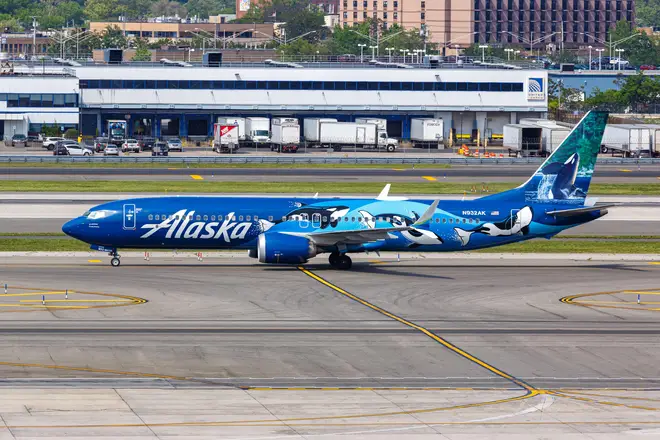
James O'Brien 10am - 1pm
8 January 2024, 12:41

A plane that suffered a fuselage blow out, leaving a gaping hole in its side, had pressurisation warnings days earlier, investigators said.
Passengers were left terrified after the incident on Friday forced the Alaska Airlines Boeing 737-9 to turn around at 16,000ft and return to Portland International Airport in Oregon.
Alaska Airlines had previously prevented the flight from travelling over water, according to Jennifer Homendy of the US National Transportation Safety Board (NTSB).
The airline put the measure in place so that the aircraft "could return very quickly to an airport" if the warning light reappeared, Ms Homendy said.
A warning light indicating pressurisation issues had gone off on three separate flights, on December 7, January 3 and finally on January 4, the day before the incident itself, in which a plug covering an unused exit door blew off the Boeing 737 Max 9 as it cruised about three miles over Oregon.

The NTSB said a schoolteacher found the lost door plug on Sunday near Portland in his back yard.
Investigators will examine the plug, which is 26 by 48 inches, to work out how it came off.
The NTSB will not be able to hear what went on in the cockpit during the flight. The cockpit voice recorder - one of two so-called black boxes - recorded over the flight's sounds after two hours, Ms Homendy said.
Ms Homendy gave new details about the chaos that took place as the plane travelled from Portland to Ontario, California.
The explosive rush of air damaged several rows of seats and pulled insulation from the walls. The cockpit door flew open and banged into a lavatory door.
The force ripped the headset off the co-pilot and the captain lost part of her headset. A quick reference checklist kept within easy reach of the pilots flew out of the open cockpit.
Alaska Airlines Flight 1282 made an emergency landing in Portland, Oregon on January 5, after an issue with pressurization. A panel of the fuselage, including the panel’s window, popped off shortly after takeoff.
— Massimo (@Rainmaker1973) January 6, 2024
[📹 vy.covers]https://t.co/VRzA10AilE
Footage taken onboard shows passengers anxiously wait for the emergency landing as they breathe into oxygen masks, with the cabin having depressurised.
They tell each other it was lucky nobody had sat next to the part that blew out.
The Association of Flight Attendants at Alaska Airlines described the decompression was "explosive".
One passenger told Portland news station KPTV that a mother held her child to his seat.
Phones were sucked out of the plane, while a child near to the blow-out lost his shirt as the cabin depressurised.
A huge hole can be seen in the left hand side of the fuselage.
Kyle Rinker told CNN: "It was really abrupt. Just got to altitude, and the window/wall just popped off and didn't notice it until the oxygen masks came off."
Vi Nguyen told the New York Times she woke up to see an oxygen mask dangling in front of her.
"And I look to the left and the wall on the side of the plane is gone. The first thing I thought was, 'I'm going to die'," she said.
"A part of the plane flew off not even 20 minutes into our flight," said one person who posted the terror on TikTok.
The pilot told air traffic control that there was an emergency, and the plane had depressurised and needed to come back.
All 174 passengers and six crew members were safe, though one crew member was slightly injured, and Alaska Airlines has grounded its 737-9 fleet.
Ben Minicucci, the chief executive of Alaska Airlines, said: "Following tonight's event on Flight 1282, we have decided to take the precautionary step of temporarily grounding our fleet of 65 Boeing 737-9 aircraft."

The Boeing 737-9 Max was certified two months ago and has flown 145 times since mid November.
The model is the newest version of the 737.
All Max 8 and Max 9 planes were grounded for two years after two Max 8s crashed in 2018 and 2019, killing more than 300 people.
Boeing had to make changes to the automated flight control system before they were put back into service.
The company said it was gathering more information about what happened in this incident.
"We are aware of the incident involving Alaska Airlines Flight 1282," it said.
"We are working to gather more information and are in contact with our airline customer.
"A Boeing technical team stands ready to support the investigation."
In December, it told airlines to inspect planes for a potential loose bolt in the rudder control system.
And last year, the FAA urged pilots to limit their use of an anti-ice system because of fears that inlets near the engines could over heat, break away and hit the plane.